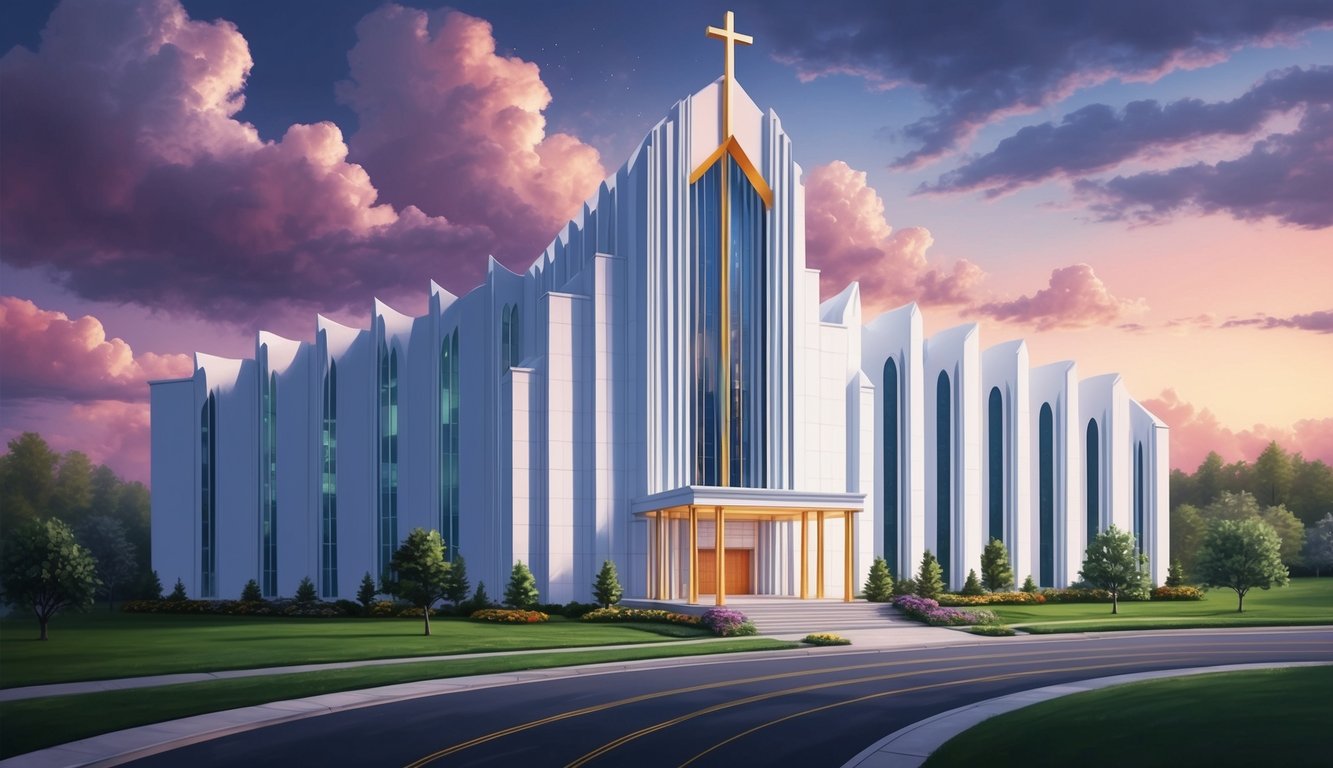Don’t Miss Out On This Unique Astrological Opportunity
Are you tired of spinning your wheels and getting nowhere? Simply put, you’re out of sync: you’re out of alignment with your astral configuration.
But: there’s a kind of map that can help you reclaim your alignment. Think of it as your own personal blueprint to success and happiness: a blueprint that will help you live your most amazing life.
Get started here.
In recent years, megachurches have become prominent in the landscape of modern Christianity.
While they attract large crowds with their engaging services and community activities, there are aspects that often go unnoticed. Understanding these hidden elements can help you discern the true nature of these institutions and how they impact faith and community.

Many people may not realize that some megachurches promote certain teachings and practices that can steer faith in complex directions.
They focus heavily on growth and financial contributions, so the line between spirituality and profit can blur. It’s important to uncover these secrets so you can make informed choices about your spiritual journey.
Tax-Free Status Misuse
Many megachurches enjoy tax-exempt status, which allows them to avoid paying property and income taxes.
This can be helpful for their operations.
However, it raises questions about fairness and accountability.
Some critics argue that this tax exemption can be abused.
When churches engage in political activities or run profit-driven businesses, it strays from their core mission.
This situation places a tax burden on regular citizens who must pay to support public services.
You may notice that some megachurches grow into large organizations.
With satellite branches and extensive media operations, their focus on expansion can overshadow their community work.
This model can resemble large corporations more than traditional churches.
The relationship between megachurches and the community can also be complex.
While they provide services and outreach programs, the financial impact on local taxes can be significant.
Finding balance is crucial in ensuring that the needs of all community members are met.
Luxury Pastor Lifestyles
Many mega church leaders enjoy a lifestyle of luxury that can seem surprising.
You might see them in expensive cars, wearing designer clothes, and living in large, beautiful homes.
This kind of wealth often raises questions among church members.
These pastors may travel in private jets or stay in luxury hotels.
This opulence can be hard to understand, especially when their message focuses on humility and sacrifice.
Some followers wonder if all the donations are being used wisely.
The money that goes into these lavish lifestyles can create a divide between the leaders and their community.
It’s important to think about how these choices align with the values of generosity and service in many faiths.
While some believe this kind of lifestyle is deserved as a reward for hard work, others say it takes away from the church’s mission.
You may find that this topic sparks meaningful conversations about fairness, accountability, and what it means to lead a true Christian life.
Voluntary Donations or Obligations?

When attending a megachurch, you might feel encouraged to donate, but what if it feels more like an obligation? Many people want to support their church, but sometimes the pressure can be overwhelming.
Megachurches often emphasize the importance of giving.
They may use persuasive messages to inspire donations, linking it closely to faith and blessings.
This can make you feel like your financial support is a requirement for spiritual growth.
Some congregants may worry about how their money is used.
Transparency can be lacking.
It’s important to know where your donations go and how they impact the church community.
In many cases, donations are presented as voluntary.
Yet, the environment can create expectations that make you feel like you must give, even if it stretches your budget.
This can lead to stress instead of joy.
Recognizing the difference between genuine giving and feeling pressured can help you make better choices.
Your donations should come from a place of love and willingness, not an obligation.
Take time to reflect on your motivations and ensure they align with your values.
Volunteer Burnout
Volunteer burnout is a real issue in many megachurches.
The high demand for volunteers can lead to feelings of exhaustion and stress.
When you are asked to take on many roles, it can be hard to keep up.
You might find yourself prioritizing church duties over your own spiritual needs.
This can make you feel disconnected from your own faith.
It’s important to remember that serving should be uplifting, not draining.
Many megachurches have rigid schedules.
This makes it difficult for volunteers like you to balance your time.
If you feel overwhelmed, it’s okay to voice your concerns.
Creating a flexible volunteer schedule can help.
This allows you and others to serve without burning out.
Open communication with church leaders is key.
They should recognize when volunteers need support and encouragement.
Everyone deserves to feel valued and connected in their community.
Keeping a healthy balance between service and personal growth is essential for a sustainable volunteering experience.
Questionable Financial Transparency
Many mega churches raise concerns about their financial practices.
You might wonder where all the money goes.
Often, these churches do not fully disclose their income and expenses.
Some mega churches encourage members to give large donations, sometimes under the idea that it shows faith.
You may find it troubling that the financial details can be vague.
This lack of clarity can lead to mistrust.
These churches enjoy tax-exempt status, which means they do not pay taxes like regular businesses.
While this is standard for religious organizations, it raises questions about accountability.
Without oversight, it can be hard to know how funds are used.
Many leaders of mega churches live in luxurious homes or drive expensive cars.
This can seem inappropriate, especially when many members struggle financially.
You might question if these leaders are prioritizing their needs over their congregation’s welfare.
In recent years, discussions have started about the need for better transparency in church finances.
You may hope for a more open approach, allowing you and others to understand how donations are spent.
Transparency can help build trust in the church and its mission.
Superficial Community Bonds

In many megachurches, community feeling can seem strong on the surface.
You may find large gatherings, exciting events, and friendly faces.
It all feels vibrant and welcoming.
However, these connections can sometimes be shallow.
The sheer size of the congregation makes it hard for real friendships to form.
You might know many people by face, but you may not know them on a personal level.
Smaller churches often provide more intimate settings.
There, you can build meaningful relationships over time.
In megachurches, people might come and go without truly connecting.
Some members may feel more like participants than part of a community.
This can leave you feeling isolated, even in a crowd.
You attend services and events, but genuine support may be missing when times get tough.
While megachurches offer a sense of togetherness, it’s important to seek deeper connections.
Look for opportunities to engage in smaller groups or classes where you can build lasting relationships.
7) Celebrity Worship Syndrome

Celebrity Worship Syndrome happens when people admire famous personalities so much that it becomes an obsession.
This can lead to feelings of preoccupation and intense focus on their lives.
In the context of megachurches, you might notice a similar trend.
Some congregants may start to place church leaders on a pedestal, treating them like celebrities.
This can create a disconnect between the members and the core message of the faith.
When the focus shifts from spiritual growth to idolizing personalities, it can be harmful.
It may hinder your personal relationship with God as you rely more on the leader than on your own faith.
It’s important to remember that everyone, including church leaders, is human.
They make mistakes and have flaws just like anyone else.
Keeping this in mind can help you maintain a balanced view and avoid unhealthy attachments.
By focusing on your faith and community instead of specific personalities, you can cultivate a more genuine and fulfilling spiritual life.
Celebrate the faith rather than the figures, and you’ll find deeper connections within your church.
Misleading Miracle Claims

Many mega churches promote miraculous healings and transformations.
These claims can draw in large crowds and create a sense of excitement.
However, not all reported miracles hold up under scrutiny.
Some churches use emotional stories to sway people’s faith.
You might hear about a person who was healed during a service.
Yet, these claims often lack solid evidence or follow-up details.
Furthermore, these miracle claims can create false hope.
If you believe a pastor can cure your illness or solve your problems, it might lead to disappointment when reality doesn’t match up.
It’s important to approach such claims with caution.
Many faithful followers seek genuine support and faith, but miracle reports can take the focus away from community and real help.
Being aware of these practices helps you stay grounded in your faith.
Remember, true faith often lies in the everyday support and love found within a community, not just in dramatic claims of miracles.
9) Leadership Scandals

In megachurches, leadership scandals can shake the foundation of faith for many members.
When leaders act in ways that are not aligned with their teachings, it can feel like a betrayal.
Such incidents often lead congregants to question their beliefs and the integrity of religious institutions.
Some seek solace in scripture, turning to discussions like Book of Revelations explained to find meaning in the chaos.
Others may leave the church altogether, disillusioned by the contradiction between preaching and practice.
These scandals often involve financial mismanagement or personal misconduct.
You may have heard about high-profile cases where pastors faced serious accusations.
The impact of these scandals can be significant.
Trust in church leadership can wane quickly, leading to declining attendance and support.
Some churches struggle to recover after such events.
The fallout can affect not just the church but also its community.
Many members feel confused or hurt by the actions of leaders they once respected.
It’s essential to remember that the faults of individuals do not define the entire faith.
In some cases, churches may take steps to address these issues, such as leadership changes or new accountability measures.
You might find that some communities emerge stronger after facing these challenges.
Understanding Mega Churches

Mega churches have become a notable part of the religious landscape in recent years.
They are characterized by large congregations and significant financial influence.
As a seeker of knowledge, understanding their origins and financial systems can help you make informed decisions about your own spiritual journey.
Origin and Growth
Mega churches began gaining popularity in the late 20th century.
Their rise coincided with the shift towards contemporary worship styles.
Many of these churches emphasize community and personal connection while using modern technology to reach large audiences.
The growth of mega churches can be attributed to several factors:
- Dynamic leaders: Charismatic pastors who attract followers.
- Innovative outreach: Use of media and events to engage the community.
- Comfortable settings: Attractive environments that feel welcoming.
This combination of factors has led to a significant number of believers attending mega churches across the United States and beyond.
Financial Structures
Financially, mega churches often operate like businesses.
They rely heavily on tithes and donations from members.
The model encourages giving, with many churches promoting the idea of prosperity theology.
This teaching suggests that financial contributions will lead to personal blessings.
Some key aspects of financial structures include:
- Opulent facilities: Many mega churches invest in high-quality buildings and amenities.
- Salary of pastors: Leaders can earn substantial salaries, raising concerns for some congregants.
- Lack of transparency: Many mega churches do not disclose how funds are spent, leading to questions about accountability.
This financial model can lead to dramatic disparities between church leaders and their congregations, which some see as a troubling aspect of mega church culture.
Cultural Impact

Mega churches can significantly shape their communities and local economies.
Their influence extends beyond spiritual guidance, often creating unique community dynamics and economic changes.
Community Dynamics
Mega churches often become central hubs in a community.
Many members develop a strong sense of belonging, which can foster friendships and support networks.
These churches frequently host events, such as:
- Concerts
- Conferences
- Volunteer opportunities
This involvement can lead to increased social interaction among members.
However, there can also be negative effects.
Some smaller, traditional churches may struggle to retain members and resources.
This shift can create a divide within the community between mega church attendees and those who prefer smaller congregations.
You may notice that the values promoted by mega churches often reach into local culture.
For example, they might emphasize themes like community service and family values, impacting how people view these priorities.
Influence on Local Economies
The financial power of mega churches is substantial.
Many operate with annual budgets exceeding $5 million.
To support their activities, they often employ a large number of staff.
This can have both positive and negative effects on the local economy.
Increased employment opportunities are one benefit.
However, the concentration of resources in one location can divert money from other businesses and charitable organizations.
Mega churches may also attract visitors who spend money on local businesses, such as:
- Restaurants
- Hotels
- Shops
While this tourism can boost the local economy, it can create competition for smaller businesses that rely on local patronage.
The presence of these large institutions can shift community priorities and resources, influencing which organizations and causes receive support.
Frequently Asked Questions
Many people have questions about megachurches and their practices.
This section covers key topics, including their financial practices, community impact, and the concerns some people have about their operations.
What financial practices lead to the wealth of megachurches?
Megachurches often benefit from tax-free status, which allows them to keep more of the money donated.
Some churches encourage members to give large sums, sometimes prioritizing donations over personal bills or expenses.
This model can lead to significant wealth for the church and its leaders.
How does church size impact the sense of community in megachurches?
In large congregations, it can be easy to feel lost in the crowd.
Many members desire the close connections found in smaller churches.
While megachurches offer programs for small groups, some find it challenging to form deep relationships amid the size and scale of the services.
What are the common criticisms faced by megachurch leaders?
Megachurch leaders often face criticism for their luxurious lifestyles, including expensive cars and homes.
Many question whether these leaders should truly live in such wealth, especially when the church relies on donations from members.
Some believe this contradicts the values of humility and service.
How do megachurches influence local economies and infrastructures?
Megachurches can significantly impact local communities by bringing in large crowds and boosting nearby businesses.
They often host events that attract visitors, which benefits local shops and restaurants.
However, their presence can also strain local resources and infrastructure due to increased traffic and demand for services.
In what ways do megachurches engage with technology and media?
Many megachurches use technology to reach more people.
They often stream services online or use social media to connect with members.
This approach helps them gather larger audiences but raises questions about the impact on personal connections and traditional worship experiences.
What role does transparency play in the operation of megachurches?
Many members and outsiders consider transparency a significant concern.
Some megachurches share their financial records, while others do not.
This lack of transparency can lead to distrust among members.
People want to ensure their donations are used responsibly.



